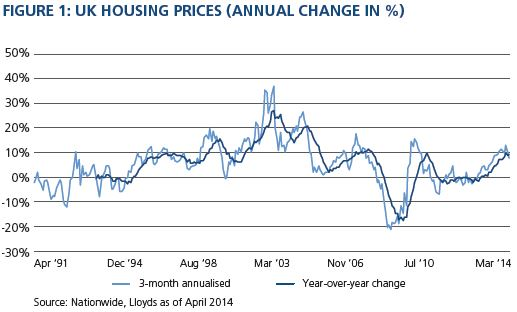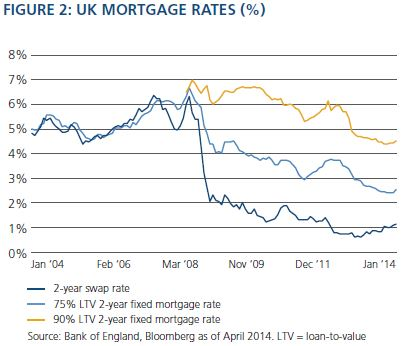The sky-high rise of UK property prices
As many of us are aware, there are two most British of conversations – the weather and house prices. Maybe it is because we have just experienced the wettest winter since records began in 1910 (according to the UK National Weather Service), or maybe it is because house prices have experienced a remarkable renaissance. Once again, the whole nation appears to be focused on the performance of the UK housing market. Jon Cunliffe, the recently appointed Deputy Governor for Financial Stability at the Bank of England, called housing “the brightest light” on the risk dashboard of the Financial Policy Committee, while the vast majority of questions at the BoE’s May 2014 Inflation Report press conference centred around the prospects of a bubble having developed in the UK housing market. With that in mind, what is the state of the UK housing market? And, more importantly, what are its investment implications?
Prices are rising faster than volumes
As most readers are aware, UK house prices have been rising strongly for much of the last 12 months, with increases of 10 per cent now common across major house price indices (see figure 1).

We also know that over the long run, house prices cannot continually outpace the rise in household earnings. Given average weekly earnings growth of 1.7 per cent at the time of writing (UK Office of National Statistics as of March 2014), the first obvious point to note is that 10 per cent house price growth cannot be sustained without something truly remarkable happening to average earnings (and frankly, if average earnings were growing at 10 per cent, that would likely present up an even bigger set of problems).
What started it? And, importantly, is it sustainable?
While there is much debate about the cause of the turnaround in the UK housing market, its seems pretty clear that a combination of falling mortgage rates, less systemic risk from Europe and the UK government’s “Help to Buy” scheme have all contributed to the improvement in the housing market (see figure 2). Although the “Funding for Lending Scheme” at the BoE has also been cited by some as a key stimulant, we believe this has been a less powerful factor than the other reasons we have cited.

Indeed, the most recent decline in UK mortgage rates commenced in the third quarter of 2012, shortly after the pinnacle of the eurozone debt crisis and coincident with the subsequent fall in bank funding costs across Europe, including the UK. There are a number of fascinating aspects to figure 2, some of which we will return to later. For now, let it suffice that we appear to be going through a very traditional monetary cycle involving lower mortgage rates, higher house prices and then – hopefully – higher transactions, greater house building and a growth handoff to the business sector (via higher investment spending, rising productivity and then real wage growth).
To date, the improvement in housing transactions in the UK has been very disappointing, with volumes still barely at levels consistent with previous cycle lows; there is certainly ample scope for transactions to rise. To make the recovery more sustainable, we would need to see higher volumes (and lower price rises would be most welcome). Unfortunately, until the banking system is fully recapitalised, and therefore able to provide additional financing for (risky) new home building, it is hard to see a rapid acceleration in UK housing transactions. This should be a warning to us all. Without a fully rehealed banking system, and absent a government programme to significantly increase social housing projects, it remains likely that prices will continue to take the lion’s share of the improvement in UK housing sentiment.
Are valuations stretched?
There are a number of ways to look at valuations, including house price/earnings ratios, the cost of owning a house compared to renting and housing affordability indices (comparing the proportion of earnings needed to service a mortgage being amongst the most popular indices). We believe that the simple combination of a house price/earnings ratio and an assessment of affordability provides you with enough information to make a reasonable assessment of the current state of the UK housing market.
For starters, the average house currently costs just under five times average earnings. Figure 3 may suggest that this is not too bad; however, just pause for a moment before drawing that conclusion. For example, current levels are commensurate with the peak ratio seen ahead of the prior UK housing boom in the late 1980s, and we are still some 16 per cent above the average UK house price/earnings ratio of the last 30 years.

It is also pretty clear why house prices are rising – mortgage costs as a percentage of disposable income remain low. Mortgage payments on a typical repayment mortgage are just under 30 per cent of disposable income, and have rarely been lower. In short, house prices in the UK are going up because the cost of servicing the debt has been coming down (see figure 4).

What happens when rates start to rise?
All of this raises the obvious question – if house prices are rising as a result of low borrowing costs and improved access to mortgage financing, what happens when those factors reverse? Interestingly, we now have policy tools available to the BoE that can address both of those aspects of housing finance. As part of its tool kit, the FPC has the ability to raise the cost of providing mortgage finance via the banking system, which would in turn restrict supply (and possibly the price). Meanwhile, the Monetary Policy Committee retains the blunter tool of raising interest rates. In BoE parlance, the FPC is the “first line of defence”, while the MPC is the “second line of defence”. That basically means we should expect the FPC to try to tighten up access to mortgage financing first before the MPC acts to raise interest rates (which has a broader effect across the economy).
While the activity of the FPC in the months and quarters ahead will undoubtedly prove fascinating, particularly for those interested in both the housing market and the broader markets, it is the activity at the MPC that will prove the most interesting. It is here that we would like to take you back to figure 2, showing UK mortgage rates alongside the UK swap rate, which you can think of as a broad proxy for the current cost of funds to the banking system. Prior to the global financial crisis, the cost of funds to the banking system equated to the interest rate available on a 75 per cent loan-to-value mortgage. In contrast, post-crisis we have seen mortgage rates come down by much less than swap rates. Given this development, and the fact that house prices look high relative to long-term metrics, it seems sensible to believe BoE Governor Mark Carney’s repeated statements along the lines of “any hikes in official interest rates will be gradual and will have a much lower terminal point than those seen before the crisis”.
New Neutral rates will be a part of the UK environment for years to come
As my colleagues Bill Gross and Richard Clarida elaborated in PIMCO’s recently published May 2014 Secular Outlook, “The New Neutral”, we expect secularly low official interest rates to support growth given continued high levels of aggregate debt. This will most certainly include the UK, where gross levels of debt remain high, the banking system remains under regulatory pressure and the savings rate remains low. As we have seen in the last 12 months, that does not preclude an economic recovery; but it does strongly suggest that the interest rate cycle will be modest and that low rates will be a characteristic of the UK economy for years to come. So, to answer the initial question – do we believe there is a housing bubble? No. An overvalued asset that will be secularly supported by low policy rates? Yes.
As for our view of the broader investment implications, while the UK bond market will go through its usual cycle, investors should get used to low rates for the foreseeable future. Credit selection and “spread product” will remain supported by benign underlying interest rates and a gradually healing economy, while inflation will be underpinned by modest (but respectable) domestic and global aggregate demand.
As with the global market, mid- to low-single-digit total returns for bonds look likely, which together with any PIMCO alpha should be sufficient to create the potential for a relatively attractive real return. It may not sound like much, but for a fairly low risk asset in an economy likely to grow at 2 per cent to 2.5 per cent in real terms over the secular horizon, this is not such a bad deal.
Mike Amey is a managing director and portfolio manager in Pimco's London office.
© Pacific Investment Management Company LLC. Republished with permission. All rights reserved.
















